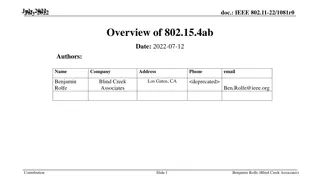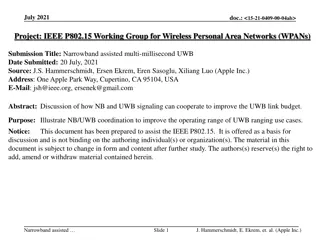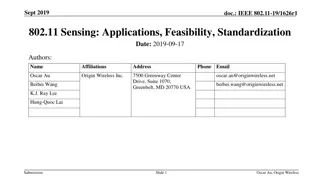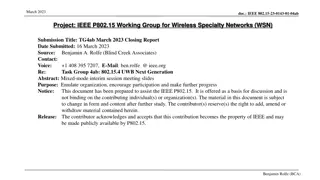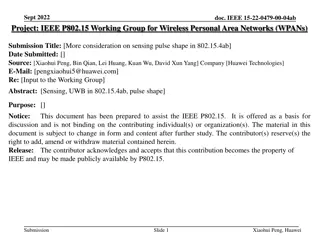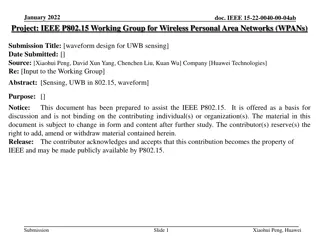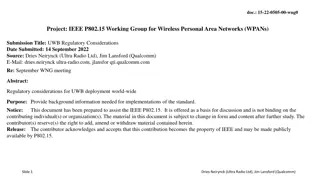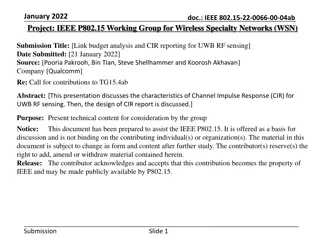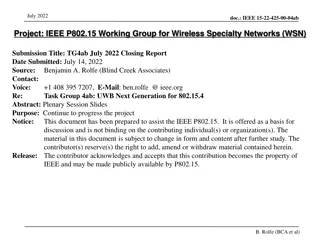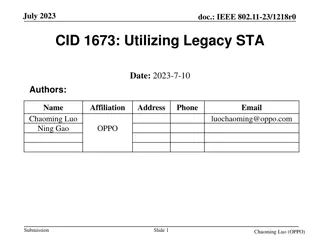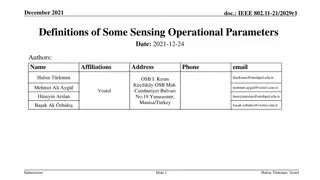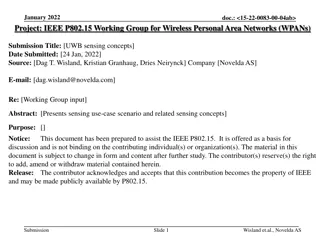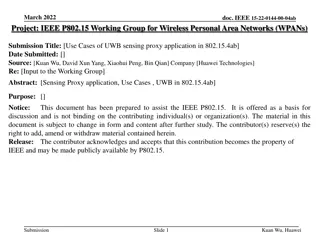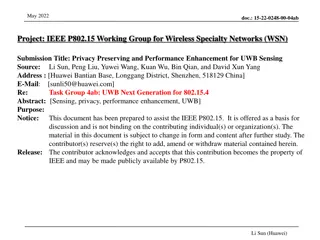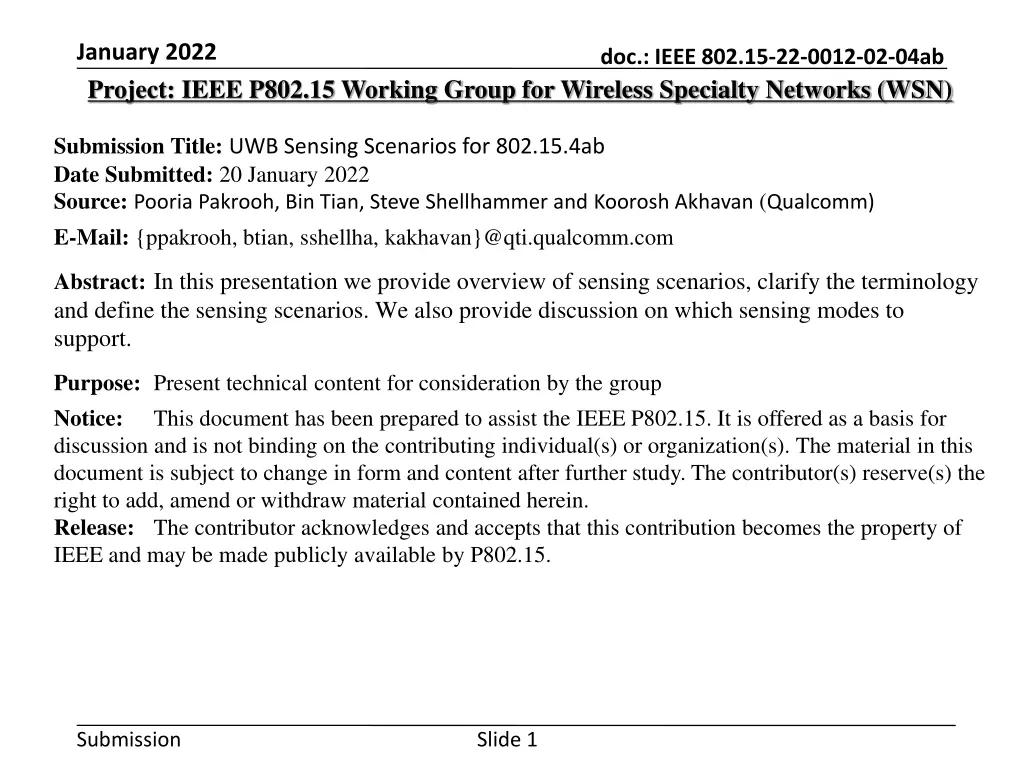
UWB Sensing Scenarios for IEEE 802.15.4ab
Explore UWB sensing scenarios and terminology for IEEE 802.15.4ab, discussing possible modes to support. Submission includes in-depth analysis and proposals for addressing various use cases, ensuring compatibility and efficiency in wireless specialty networks.
Download Presentation

Please find below an Image/Link to download the presentation.
The content on the website is provided AS IS for your information and personal use only. It may not be sold, licensed, or shared on other websites without obtaining consent from the author. If you encounter any issues during the download, it is possible that the publisher has removed the file from their server.
You are allowed to download the files provided on this website for personal or commercial use, subject to the condition that they are used lawfully. All files are the property of their respective owners.
The content on the website is provided AS IS for your information and personal use only. It may not be sold, licensed, or shared on other websites without obtaining consent from the author.
E N D
Presentation Transcript
January 2022 Project: IEEE P802.15 Working Group for Wireless Specialty Networks (WSN) doc.: IEEE 802.15-22-0012-02-04ab Submission Title:UWB Sensing Scenarios for 802.15.4ab Date Submitted: 20 January 2022 Source:Pooria Pakrooh, Bin Tian, Steve Shellhammer and Koorosh Akhavan (Qualcomm) E-Mail: {ppakrooh, btian, sshellha, kakhavan}@qti.qualcomm.com Abstract:In this presentation we provide overview of sensing scenarios, clarify the terminology and define the sensing scenarios. We also provide discussion on which sensing modes to support. Purpose: Present technical content for consideration by the group Notice: This document has been prepared to assist the IEEE P802.15. It is offered as a basis for discussion and is not binding on the contributing individual(s) or organization(s). The material in this document is subject to change in form and content after further study. The contributor(s) reserve(s) the right to add, amend or withdraw material contained herein. Release: The contributor acknowledges and accepts that this contribution becomes the property of IEEE and may be made publicly available by P802.15. Submission Slide 1
January 2022 PAR Objective Safeguards so that the high throughput data use cases will not cause significant disruption to low duty-cycle ranging use cases Interference mitigation techniques to support higher density and higher traffic use cases Other coexistence improvement Backward compatibility with enhanced ranging capable devices (ERDEVs) Improved link budget and/or reduced air-time Additional channels and operating frequencies Improvements to accuracy / precision / reliability and interoperability for high-integrity ranging Reduced complexity and power consumption Hybrid operation with narrowband signaling to assist UWB Enhanced native discovery and connection setup mechanisms Sensing capabilities to support presence detection and environment mapping doc.: IEEE 802.15-22-0012-02-04ab Proposed Solution (how addressed) Discussing possible UWB sensing scenarios Low-power low-latency streaming Higher data-rate streaming allowing at least 50 Mbit/s of throughput Support for peer-to-peer, peer-to-multi-peer, and station-to-infrastructure protocols Infrastructure synchronization mechanisms Submission Slide 2 P. Pakrooh et. al (Qualcomm)
January 2022 doc.: IEEE 802.15-22-0012-02-04ab Introduction In this presentation we provide overview of sensing scenarios Clarify the terminology and define the sensing scenarios o An effort has been made to use terminology consistent with UWB ranging and 802.11bf RF sensing [1] o In most RF Sensing scenarios, the Initiator is the device where the RF sensing application resides. The proxy scenario is the exception to this rule. Discussion is needed as to whether the proxy should be supported in 802.15.4ab o Based on the roles of the initiator/responder in the sensing task, we present possible sensing modes for 802.15.4ab. Discussion on which sensing modes to support is needed. Submission Slide 3 P. Pakrooh et. al (Qualcomm)
January 2022 doc.: IEEE 802.15-22-0012-02-04ab Sensing terminology Generalizing the terminology from the context of ranging to RF sensing Definition Term Initiator The sensing device that initiates the RF sensing session with one or more other UWB devices Responder The sensing device that responds to the sensing Initiator Sensing transmitter The sensing device that sends the channel sounding PPDU to enable channel estimation for RF sensing purposes Sensing receiver The sensing device that receives the channel sounding PPDU from the transmitter and performs channel estimation CIR measurement report for upper layer processing Internal device channel impulse response report to upper layer for processing OTA CIR measurement report Over the air channel impulse response feedback report Submission Slide 4 P. Pakrooh et. al (Qualcomm)
January 2022 doc.: IEEE 802.15-22-0012-02-04ab UWB Sensing Scenarios: Mono-Static sensing Object being UWB Tx/Rx sensed o A single UWB device acts as both the sensing transmitter and sensing receiver and runs the RF Sensing application o No OTA CIR measurement report is required as there is only one UWB device involved. o The single UWB device is responsible for all the sensing steps, including sensing initiation, processing of the result and generating CIR measurement report for upper layer processing. o This scenario requires the UWB device so transmit and receiver simultaneously (e.g., Full Duplex operation) o Full duplex (FD) operation significant challenge of self interference cancellation: Need to investigate complexity and power consumption to check feasibility of FD for 15.4ab o Since only one device is involved, this can be implementation specific and may not need standard support. Submission Slide 5 P. Pakrooh et. al (Qualcomm)
January 2022 doc.: IEEE 802.15-22-0012-02-04ab UWB Sensing Scenarios: Bi-static Sensing o Mode A [Initiator is the sensing receiver]: OTA CIR measurement report is not required Initiator measures channel and generates CIR measurement report for upper layer processing Responder/ Tx Initiator/Rx Object being sensed Sensing packet Submission Slide 6 P. Pakrooh et. al (Qualcomm)
January 2022 doc.: IEEE 802.15-22-0012-02-04ab UWB Sensing Scenarios: Bi-static Sensing o Mode B [Initiator is the sensing transmitter]: OTA CIR measurement report is required Initiator/ Tx Responder/Rx Object being sensed Sensing packet OTA CIR measurement report Submission Slide 7 P. Pakrooh et. al (Qualcomm)
January 2022 doc.: IEEE 802.15-22-0012-02-04ab Discussion of bi-static modes o Mode A does not have feedback overhead, as no OTA CIR measurement report is required. Mode A is more power efficient for Responder as it does not require to send feedback and requires less processing to generate the feedback. May be easier to enable legacy devices for mode A, no adoption for feedback requirement. Assuming channel is reciprocal, mode A is preferred, so it needs to be supported. Support of mode B may be optional. o o o Submission Slide 8 P. Pakrooh et. al (Qualcomm)
January 2022 doc.: IEEE 802.15-22-0012-02-04ab UWB Sensing Scenarios: Multi-static sensing o Mode A: Initiator is the receiver. Responders are transmitters: OTA CIR measurement report is not required Responder1/Tx Object being sensed Initiator/Rx Responder2/Tx Sensing packet o Since 15.4 does not support simultaneous transmission then mode A is basically equivalent to performing multiple bi-static sensing instances sequentially with multiple responders. Submission Slide 9 P. Pakrooh et. al (Qualcomm)
January 2022 doc.: IEEE 802.15-22-0012-02-04ab UWB Sensing Scenarios: Multi-static sensing o Mode B: Initiator is the transmitter. Responders are receivers. Multiple OTA CIR measurement reports are required. Responder1/Rx Object being sensed Initiator/Tx Responder2/Rx Sensing packet OTA CIR measurement report 1 OTA CIR measurement report 2 o Mode B needs scheduling for OTA CIR measurement reports from multiple responders to the initiator. Submission Slide 10 P. Pakrooh et. al (Qualcomm)
January 2022 doc.: IEEE 802.15-22-0012-02-04ab UWB Sensing Scenarios: Proxy application o Proxy enables a device to request the CIR measurement report for sensing while not being initiator or responder. o Initiator performs sensing with one or more responders. o Initiator reports the OTA CIR measurement report to the device which requested it. Useful in 802.11 where the AP can make all channel measurements and report them to the non-AP client STA. Usefulness for 802.15.4ab can be discussed depending on possible use cases. Submission Slide 11 P. Pakrooh et. al (Qualcomm)
January 2022 doc.: IEEE 802.15-22-0012-02-04ab UWB Sensing Scenarios: Proxy application oMode A: Initiator is the sensing receiver, responder(s) are sensing transmitters Responder/Tx ?1 Object being sensed Requesting device ?2 Initiator/Rx ? Sensing request Sensing packet OTA CIR measurement report ? ?1,?2 Submission Slide 12 P. Pakrooh et. al (Qualcomm)
January 2022 doc.: IEEE 802.15-22-0012-02-04ab UWB Sensing Scenarios: Proxy application o Mode B: Initiator is the sensing transmitter, responders are sensing receivers Mode B requires two instances of OTA CIR measurement report. Initiator/Tx ? ?1,?2 ? ?1 Object being sensed Requesting device ?2 Responder/Rx Sensing request Sensing packet OTA CIR measurement report Submission Slide 13 P. Pakrooh et. al (Qualcomm)
January 2022 doc.: IEEE 802.15-22-0012-02-04ab Discussion The IEEE 15.4ab Task Group needs to decide which RF Sensing scenarios to support so that the corresponding protocol can be defined o Following is our preliminary recommendation for discussion RF Sensing Scenario Recommendation Comments Mono-Static Sensing Not support, open for more discussion Requires more study on the feasibility of full-duplex implementation. May not need standard support Bi-Static Sensing: Mode A [Initiator=sensing receiver] Support Core UWB sensing scenario Bi-Static Sensing: Mode B [Initiator=sensing transmitter] Support: can be optional Higher overhead for OTA CIR report Submission Slide 14 P. Pakrooh et. al (Qualcomm)
January 2022 doc.: IEEE 802.15-22-0012-02-04ab Discussion The IEEE 15.4ab Task Group needs to decide which RF Sensing scenarios to support so that the corresponding protocol can be defined RF Sensing Scenario Recommendation Comments Multi-Static Sensing: Mode A [Initiator=sensing receiver] Support: can be optional Equivalent to multiple bi-static sensing sessions sequentially Multi-Static Sensing: Mode B [Initiator=sensing transmitter] Support: can be optional Requires scheduling for OTA CIR measurement reports from responders Proxy Do not Support: open for more discussion Need to establish use cases for 802.15.4ab Submission Slide 15 P. Pakrooh et. al (Qualcomm)
January 2022 doc.: IEEE 802.15-22-0012-02-04ab References 1. Claudio da Silva, IEEE 802.11bf Specification Framework Document, IEEE 802.11-21/504r4, November 2021 2. Frank Leong, Wolfgang K chler, Riku Pirhonen, UWB Sensing in 802.15, IEEE 802.15-21/399r0, July 2021 3. Xiaohui Peng, David Xun Yang, Chenchen Liu, Rani Keren, Kuan Wu, CIR feedback for UWB sensing, IEEE 802.15-21/570r0, November 2021 Submission Slide 16 P. Pakrooh et. al (Qualcomm)


